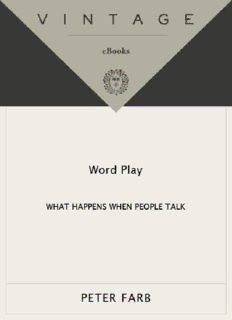
Word play : what happens when people talk PDF
Preview Word play : what happens when people talk
Also by Peter Farb MAN’S RISE TO CIVILIZATION as Shown by the Indians of North America from Primeval Times to the Coming of the Industrial State YANKEE DOODLE (A Fiction) ECOLOGY FACE OF NORTH AMERICA LIVING EARTH THE ATLANTIC SHORE: Its Human and Natural History (with John Hay) For Mark and Tom CONTENTS Cover Also by Peter Farb Title Page Copyright Dedication ACKNOWLEDGMENTS INTRODUCTION: THE PLAY AND THE PLAYERS I The Game 1 THE ECOLOGY OF LANGUAGE 2 SPEECH SITUATIONS 3 WORDS AND DEEDS II The Strategies 4 THE SPEAKABLE AND THE UNSPEAKABLE 5 VERBAL DUELING 6 PLAYING WITH LANGUAGE 7 LINGUISTIC CHAUVINISM III Is the Game Rigged? 8 MAN AT THE MERCY OF LANGUAGE 9 HOW TO TALK ABOUT THE WORLD 10 IN OTHER WORDS IV Born to Speak 11 MAN THE TALKER 12 THE LANGUAGE OF CHILDREN 13 THE SPOKEN WORD 14 MAKING COMBINATIONS V The Changing Game 15 LANGUAGE IN FLUX 16 REPAIRING BABEL REFERENCES BIBLIOGRAPHY About the Author ACKNOWLEDGMENTS And for ther is so gret diversite In Englissh, and in writyng of oure tonge, So prey I God that non myswrite the Geoffrey Chaucer’s prayer in Troilus and Criseyde is mine as well. To write about language and also to present a report on the state of linguistic research demanded that I explore many disciplines—linguistics, anthropology, sociology, psychology, ethology, poetics, and so on—and consequently expose myself to the hazards of interdisciplinary points of view. Further, in writing about language I had no alternative but to use the medium of language itself—which is nearly as difficult as lifting oneself by one’s bootstraps. My task has been eased considerably by the generous assistance of many people. I am greatly in the debt of the following scholars who kindly read the sections of the manuscript that fell within their disciplines and who offered valuable suggestions: Joel Sherzer, Department of Anthropology, University of Texas at Austin; Charles Clifton, Department of Psychology, University of Massachusetts at Amherst; James T. Heringer, Department of Linguistics, University of Massachusetts at Amherst; and Irven DeVore, Department of Psychology and Social Relations, Harvard University. It would be misleading for me to suggest that these readers found themselves in complete agreement with every idea expressed in this book; nor is it likely that consensus could ever be reached in a field so new and controversial as the one this book is about. In the course of working on the manuscript I have also been the fortunate recipient of advice and kindness from: Roger D. Abrahams, Director of the African and Afro-American Research Institute, University of Texas at Austin; Thomas L. Bernard, Department of Psychology and Education, Mount Holyoke College; Gary H. Gossen, Department of Anthropology, University of California at Santa Cruz; Nancy P. Hickerson, Texas Technological University; Jim Kakumasu, Wycliffe Bible Translators, Equipe Linguistica, Belém, Brazil; Dina Sherzer, Department of English, University of Texas at Austin; Robert Taylor, Dean of Library Sciences, Syracuse University; and Frederick W. Turner III, Department of English, University of Massachusetts at Amherst. I am also grateful to film critic Pauline Kael and to Joe Adamson, of the University of Pennsylvania, for helpful suggestions and material about the Marx Brothers and visual communication. My expressions of gratitude would be grossly incomplete without mention of the conscientious people at the University of Massachusetts (Amherst) Library— particularly Donald M. Koslow, formerly in charge of the reference section, Gordon Fretwell, director of special services, and their conscientious assistants —who worked wonders in locating inaccessible research materials for me. Every page of this book reveals borrowings from scholars in many disciplines. I hope that this single, overriding recognition of that fact will express my deep appreciation and admiration for their work. Rather than attempting an invidious listing of some of their names here, let me instead direct the reader to their works cited in the References and Bibliography sections—which proclaim their devotion to their craft more than my mere words could. Ultimately, of course, I am responsible for whatever errors, inelegant expressions, or tongue-tied explanations persist in this book. Amherst, Massachusetts April 1973 PETER FARB INTRODUCTION The Play and the Players Immediately after the scene in which Hamlet hires players to act out his theory about the murder of his father, Guildenstern attempts to manipulate Hamlet with words. But Hamlet rebukes him: Why, look you now, how unworthy a thing you make of me! You would play upon me; you would seem to know my stops; you would pluck out the heart of my mystery; you would sound me from my lowest note to the top of my compass…’Sblood, do you think I am easier to be played on than a pipe? Call me what instrument you will, though you can fret me, you cannot play upon me. Hamlet fires off a barrage of puns and employs other forms of word play to make it perfectly clear that he has seen through Guildenstern’s attempt to play upon him with words. In this passage, and throughout his works, Shakespeare demonstrates that he understood how people play a game with language to achieve certain ends: to cajole or convince, to display their own wisdom to an audience, to win honor or esteem. He often states his thoughts about language with poetic intensity and apt detail—yet they are nonscientific, merely common- sense observations, no matter how artfully they are expressed. Beginning about 1960, and at an accelerating pace since then, a scientific approach has replaced common sense in interpreting the way human beings use
Description: